|
|
Post by TheWallsScreamedPoetry on May 7, 2011 12:11:43 GMT
|
|
|
|
Post by TheWallsScreamedPoetry on May 7, 2011 12:32:22 GMT
Gibson recently released a Robby Krieger special edition SG.  The Gibson Robby Krieger SG The Gibson Robby Krieger SGWhether it’s the SG Special Krieger played when he first joined the band or the dozen or so he’s owned since, Gibson SGs have played a part in all of Krieger’s work, including such classic rock staples as “Light My Fire,” “Love Me Two Times,” “Love Her Madly” and countless other songs that remain as relevant today as they were popular in the late 1960s and early 1970s. “I’ve always been drawn to a Gibson SG and Gibson guitars in general. I’ve always loved the way they look, they way they play and, of course, the sound. I love the fat sound of a Gibson … that’s how I like a guitar to sound.” Robby Krieger, guitarist, The Doors |
|
|
|
Post by TheWallsScreamedPoetry on May 7, 2011 17:09:21 GMT
Guitar & Bass MagazineGibson Robby Krieger SG VOS Review Date: Friday 21st of May 2010 Reviewed By: Dave Walsh 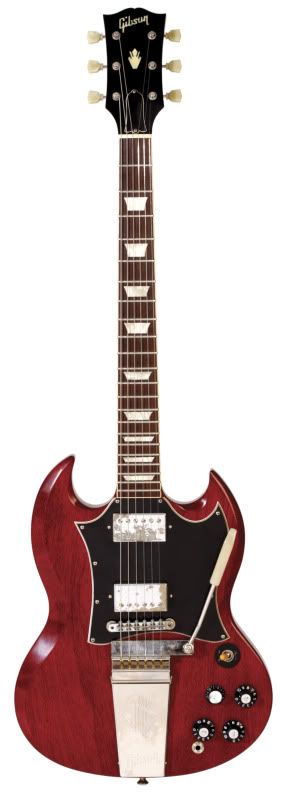 When G&B spoke to Robby a few issues ago, he explained that this was the second crack that Gibson had taken at creating a signature guitar for him. The first, with a graphite neck and a Floyd Rose (well, it was the mid-'90s) never made it into production. 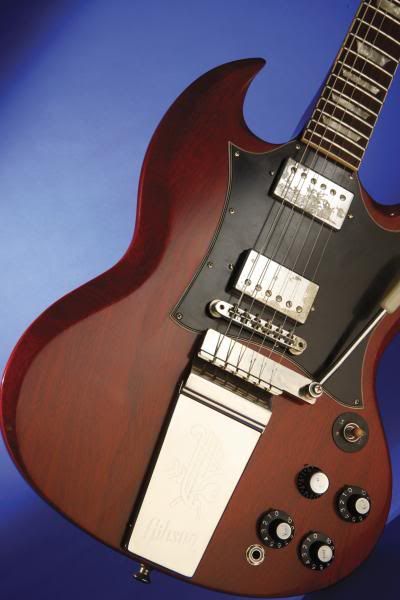 What we have here, however, is an instrument far more suited to a pioneer of '60s rock. With a run limited to just 100 pieces in this VOS (Vintage Original Spec) finish, you're purchasing a collector's item - and if you're feeling extra flush you could plump for one of just 50 fully-aged versions at around £4000 which include accurate recreation of the wear and tear from Robby's personal '67 model. A first glance this could be a tweaked Gibson Standard reissue, but in reality it's an amalgamation of several different SGs that Robby has played or owned over the years. The aged dark heritage cherry nitro-cellulose finish is dulled to replicate a lightly-worn 40-year old sheen. It even feels correct, and lacks the OTT relicing that makes many guitars look like they've been tied to the back of a truck and dragged around the streets. The result is a very authentic look and the feel of an old, used but cared for '60s SG. The weight of the 35mm one-piece mahogany body will delight those with back twinges, and the common SG neck-heaviness is balanced somewhat by the - slightly questionable - inclusion of a Gibson Maestro vibrato system. This bent steel-spring vibrato has an elaborate tailpiece that belies its functional simplicity. The Maestro has full retro credentials but it's often disabled for the sake of tuning stability, and some say it has less sustain than a Tun-O-Matic and a stop tailpiece. The travel is similar to a Bigsby's and the tuning stability is far from solid, even with stretched strings, so it's best used for slight wobbles. The vibrato unit and rest of the nickel hardware including the ABR bridge is also authentically aged, with the exception of the grotty nickel pickup covers, which look like someone has sneezed on them. Doors-spotters may note that Krieger often used an SG Special with twin P90s; here we have a pair of Gibson '57 humbuckers with a push/pull to put them out-of-phase in the mixed position, a sound Krieger uses live for Peace Frog, amongst others. Plastic parts include three aged ‘witch hat' knobs and an odd ‘bell' knob on the neck pickup volume, plus a smoky-looking toggle switch with the rhythm/lead print fading away - a neat touch. The cramped layout can take some getting used to, and it's advisable to employ a right-angled lead for sanity's sake. According to Robby, the neck is very flat backed and flamenco-like at the lower end, with a hybrid profile modelled on both a '61 SG and his own ‘67 SG Standard. In reality the flat-backed nature is not nearly as severe as promised, and it makes a comfortable progression from a shallow D shape at the lower end up to a softer, chunky roundness. After a few minutes of use all this is forgotten - you just know you're simply playing a good neck shape. The rosewood fingerboard has neatly routed inlays with 22 medium frets. There are no traditional binding ‘nibs' on the fret ends: the frets extend to the edge of the fingerboard, increasing the playing width by a few millimetres. In fact, putting my luthier hat on for a moment, the ‘re-fretted' look perfectly complements the pre-used aesthetic. 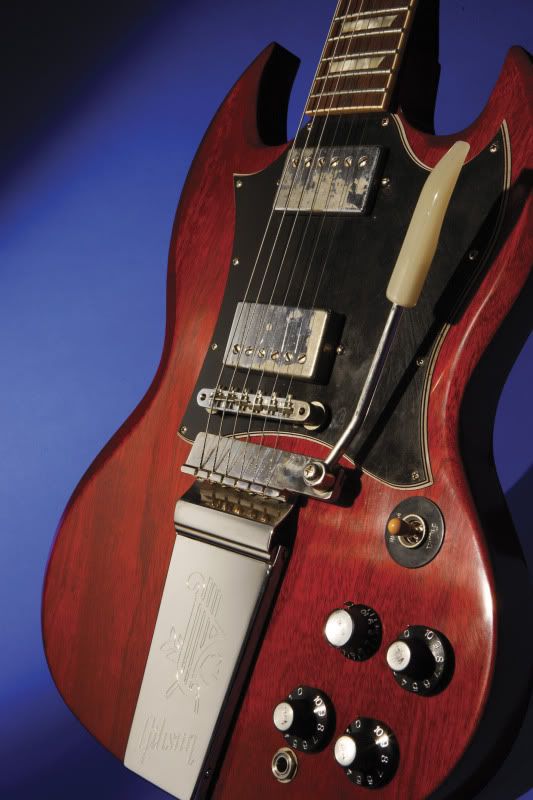 Grover-made, Gibson-badged tulip buttoned Klusons head up the black-faced headstock, which displays no Krieger signature. In fact, apart from the unmatched knob there's no indication that this is a signature guitar at all. SoundsIt always takes a few seconds to orientate to an SG. The position of the neck/heel join gives fantastic access to the higher frets, but the design pushes the headstock and fretboard away further than on other guitars. Despite playing in the wrong key for a few moments, the tone was immediate, with a woody, airy and surprising soft acoustic tone from the 10-46 gauge strings. Maybe the vibrato sucks a little natural mass from the tone, but connecting a Class A/B 1x12" combo and opening it up revealed the guitar's throaty nature. With a moderate amp gain setting but pushing the volume for an authentic old school output, the bridge pickup has that wonderful, focused midrange bark of an all-mahogany guitar with good quality, sensibly-wound humbuckers - not as flabby as a weighty Les Paul and with a tighter, more aggressive snarl. 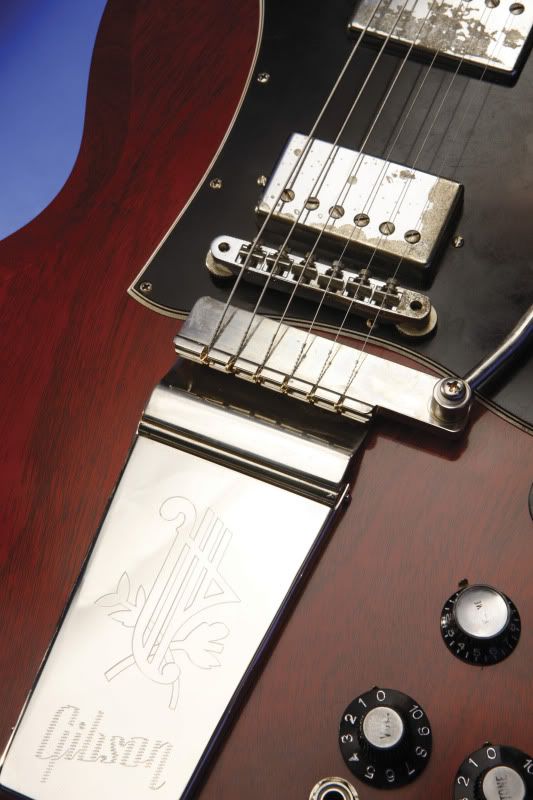 After a little height tweak to balance the outputs, the neck unit proves to be juicy and flutey and sheds the thicker woolly edge of a Les Paul in favour of dark clarity. Popping up the bridge tone pot engages the out-of-phase wiring; it's a strident, honky voice which is great with gain but less ear-friendly or usable on cleaner settings. VerdictAs signature or limited edition guitars go, this one falls on the right side of the taste fence in virtually every category. The unusual neck shape and simple wiring modification aside, it is essentially a VOS reissue - albeit a very good one. It's a little more expensive, reflecting Krieger's specs, but it's still far cheaper than a genuine mint '60s SG. The vibrato won't be to everyone's taste but the finish on both wood and hardware is excellent. The frets would benefit from a little elbow grease, but this is a small gripe on a guitar with a great feel and superb sounds. Another plus is the subtlety - without a day-glo signature, only the few will know it's an artist model... and in our book, that only adds extra kudos.
|
|
|
|
Post by TheWallsScreamedPoetry on May 8, 2011 18:29:48 GMT
Premier Guitar Interview 2010Q) You’re most known for playing a Gibson SG Standard. How did you come to use that guitar? A) Before I played electric guitars, I knew nothing about them. But then I saw Chuck Berry and had to get one. I went to a pawnshop and all I could afford was a used Gibson SG Standard—it cost me $180. That was the guitar I used in the Doors. I played ES-335s and ES-355s also, but I always went back to the SG. It’s the most comfortable guitar for me. It does what I need it to do and always has. 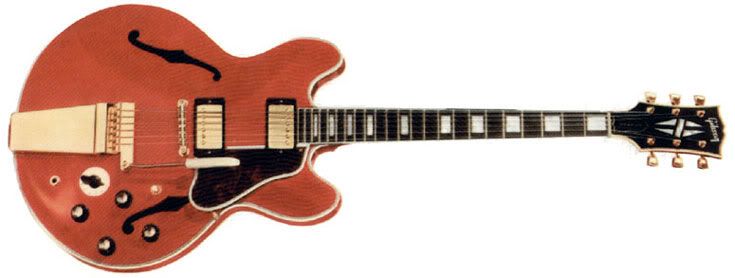 Gibson ES-355 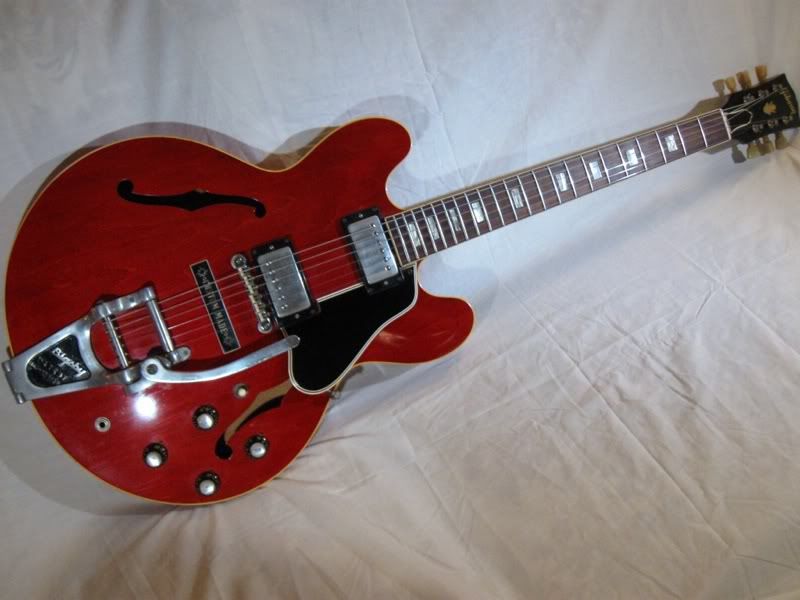 Gibson ES-335 5 Guitar Heroes Who Made It to the Top with an SG in HandRobby Krieger“When I first started playing guitar, everyone was playing Chuck Berry and B.B. King licks,” Robby Krieger once said. “I decided I was going to find other avenues of expression.” During his tenure with the Doors Krieger did just that. Utilizing his iconic red SG, Krieger brought to the band a distinctive style based on a fascination with flamenco and a deep assimilation of blues and jazz. Showcasing the melodic gifts evident on “Light My Fire,” “Touch Me,” and “Love Me Two Times”—all of which he wrote—Krieger could make his SG sing with abandon or subtly serve the song. In keeping with his flamenco background, Krieger played his SG without a pick—the better to shift easily between bass, lead, and rhythm parts. And his interest in Indian music—as exemplified on “The End”—served as a perfect backdrop for singer Jim Morrison’s shaman-like persona. from Gibson guitars lifestyle February 2011
|
|
|
|
Post by TheWallsScreamedPoetry on May 9, 2011 13:20:01 GMT
Robby Krieger Guitar Player Magazine
February 1, 1998
ON PLAYING LIVE
I was usually the loudest onstage, and they were always telling me to turn down.
We had these amps that our equipment guy made.
They looked like Acoustic amps, but they were homemade things with JBLs and 200-watt heads.
I used two cabinets: one had six 12" speakers, and the other had two 15" speakers and six 8" speakers.
The problem was the amps were so powerful that it was very hard to get them to break up.
They really didn't sound all that good, but they were loud!
We did use actual Acoustic amps for a while, and they had distortion, reverb, and tremolo built in.
They also had a built-in tuning tone that you could vary the pitch of.
However, I used the tone like a siren that's the sound you hear in the film of our London concert during The Unknown Soldier.
I don't remember using it on any other song.
It was so weird that I don't think we wanted to use it too much [laughs).
Most of the time, though, my live sound was just a guitar and an amp, and every once in a while I'd have some kind of fuzztone or an Echoplex.
ON BACKING UP DIONYSUS
I never felt as if I was playing in Jim's shadow.
Not at all. I mean, the music was always right there, you know? It was always so easy to play together, and there was never the sort of ego problems that you have with a lot of groups.
I don't know why.
Maybe the four of us just had the perfect magic circle.
Guitar World 2004
Q) Is it true that you'd been playing guitar for only six months when you joined the Doors? How did you grasp the instrument's vocabulary so quickly?
A) RK: Actually, I had been playing electric guitar for just six months when I joined the group; I'd been playing folk and flamenco acoustic for three or four years before then. When I started to play the electric, I just used the same fingerpicking style that I used on the acoustic.
That's the only method that I used when I played with the Doors, but about 20 years ago I learned to use a pick for playing speedier runs. Now I'm half and half.
|
|
|
|
Post by TheWallsScreamedPoetry on May 11, 2011 13:09:52 GMT
The Gibson SG: Celebrating 50 Years of a Rock and Roll ClassicThe Gibson SG guitar is a rock and roll classic. After its introduction in 1961, key guitarists in the rock and roll revolution of the mid ’60s, from Eric Clapton and Pete Townshend in England to Jerry Garcia, Frank Zappa and Robby Krieger in America, quickly fell in love with the slinky, new, fast-neck, double-cutaway guitar — making it one of the coolest guitars in rock and roll history. Back in 1958, Gibson started experimenting with cutaway designs for the Gibson Junior, Special and TV models. With sales of the Gibson Les Pauls maturing, the double-cutaway design was introduced in 1961 to give guitarists a different style guitar to the Les Paul. The Les Paul name stayed on the new shape guitars until 1963 when the great man’s endorsement deal expired and Gibson called it the SG, or Solid Guitar, which is how it was referred to in the factory. The name was not, sadly, anything to do with Satan’s Guitar as has been suggested by some reading too much into cutaway’s resemblance to horns. Rock and rollers everywhere gravitated towards the instrument. Eric Clapton wailed to guitar greatness with his Cream-era SG. Pete Townshend threw plenty of windmills on his trusted SG, smashed more than a few to pieces and even used one as a weapon against stage invader Abie Hoffman at Woodstock. In America, Robby Krieger honed The Doors’ revolutionary new sound on his trusted SG and Jerry Garcia used his to summon the gods of acid rock and start a merry, decades-long journey to discovery. It was obvious why people quickly responded to the new Gibson SG. The slim mahogany body of the SG was perfect for guitarists needing a lighter guitar that still packed a punch. This inspired design, with the added but crucial ingredients of a thin, all-mahogany body and neck and two Gibson humbucking pickups, gave it a sharp and snappy attack, but with a meaty deep punch. The double-cutaway body gave guitarists better access to the high frets and the hand-sanded, rounded neck allowed players to move smoothly around the fretboard and neck. It was a beautifully playable guitar. Over time, Gibson introduced a few model variations for the SG. The SG Customs had three humbuckers and a pearl inlay on the neck. The Standard had two single coils, and the Junior had a dot inlay. As mentioned, from ’61 to early ’63, the SG Standard’s truss rod cover was engraved with “Les Paul.” Until 1967 it also had just a small pick guard until a re-tweaking gave the guitar a “batwing” pickguard. And that’s how the guitar stayed until the ’70s. In 1971, a new SG was released with a floating pickguard, as on a Les Paul, and a variety of tailpieces were made available as options, such as the “Maestro,” the “Lyre Vibrola” and the Bigsby vibrato tremolo arm. In 1973, at last, Gibson returned to the original SG design, bringing back the small pick guard. In 1971, as well, Gibson issued a lower priced model, the SG 100 and a SG 200 with two single coil pickups. The company also offered a SG Pro and SG Deluxe at the top end of the range. The SG now surfaced as guitar of choice for some of the heaviest rock guitarists in history. Black Sabbath’s Tony Iommi’s gothic roar came courtesy of his favorite SG and Angus Young took heavy rock, SG style, around the globe. Away from hard rock, Duane Allman made southern rock an art form on his, while Frank Zappa employed an SG for his experimental art rock. Carlos Santana majestically fused blues, rock and Latin music on a Gibson SG. Not to be left out, pop embraced the SG, too. The Cars’ sparkling pop guitar came courtesy of Elliot Easton’s effervescent SG work. In 1980, Gibson issued the first SG with active factory pickups. It used the same Moog electronics that had been developed for the RD Artist model. This new SG had a thicker body (to accommodate the circuitry) and was originally known as the SG-R1, later the SG Artist. The model was discontinued in 1981. The pioneering electronics returned, however, in 2008 with the Robot SG and its radical electronic tuning system. In 2009, Gibson introduced the Raw Power line of SGs available in colors previously not available to the SG. Since the early ’60s, the Gibson SG guitar has evolved and adapted to rock and roll’s needs and moods and has utilized all of Gibson’s revolutionary new designs and technologies. An army of SG players will today gladly swear by the instrument, from southern rock maestros like Derek Trucks, to hard-edged rockers like Wolfmother’s Andrew Stockdale, to more poppy guitar stylists like Weezer’s Rivers Cuomo. It’s not Gibson’s best-selling guitar of all time for nothing! from Gibson guitars lifestyle February 2011Check out..... The Gibson Interview: Doors Legend Robby Krieger
|
|
|
|
Post by TheWallsScreamedPoetry on Nov 12, 2011 10:04:26 GMT
"Robby Krieger was a more a country blues guy. Slide guitar and even flamenco guitar."
Ray Manzarek
|
|
|
|
Post by TheWallsScreamedPoetry on Dec 6, 2011 17:12:16 GMT
|
|
|
|
Post by TheWallsScreamedPoetry on Feb 22, 2012 10:16:18 GMT
From Follow The Music #14
BILL SIDDONS:
I think that Robby was, to put it in art terms, the abstract artist in the group. He was Jackson Pollock pouring paint on a canvas and saying, "What's it feel like?" Completely free form, kind of just bounced off walls—"Well, that's what's happening, accept it."
My favorite quote of my whole history with the Doors came from Robby. Somebody asked him after a show, "Robby, what do you think of when you're playing your solos?
You walk around without apparent focus or aim, you're obviously somewhere else, what are you thinking about?"
Robby kind of smiled and said, "Well, I think about my aquarium a lot." And I thought it was the perfect description of his playing, floating around with his fish.
While Ray was building chord upon chord, structure upon structure. Ray was not quite the cubist, more of a literalist.
I always felt in Ray's playing, every next phrase was built on the one before, block by block. And he does that in conversation—he's a very structural person. Ray was the one who was always trying to see that control was maintained. Robby never cared about control per se, he cared about having enough order to get through what we were doing.
JAC HOLZMAN:
Robby's guitar playing looked so deceptively simple.
Mike Bloomfield would eke out an E minor chord and go into spasm on stage with the sheer bravado of his own technique.
Robby would be spinning incredible riffs and he might be watching an insect on the ceiling, or perhaps considering that in six months time he might buy another pair of jeans.
And there was that very special Brechtian feel you got from Ray Manzarek's organ. Whenever Ray played, I saw two colors: earth brown and purple. So you have the uniqueness of Ray's keyboard platform supporting exquisitely precise, liquid guitar lines from Robby, given structural integrity by John's very inventive, staccato drumming.
|
|